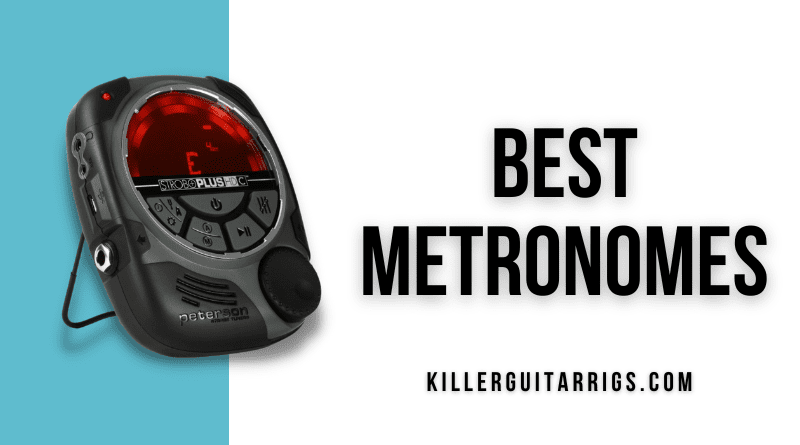The metronome is one of the most important tools a musician can rely on to improve. Although it is dreaded by some, a metronome forces you to develop a better sense of time as it offers a precise pulse to keep you on track.
Developing good time is central to being a good musician. Simply said, there are no good musicians with a bad sense of time, that just isn’t possible. And the metronome is often cited as the very best way to improve your time.
Whether you’re working on scales, chords, learning songs, licks, or pretty much anything else, the metronome can be a great tool to keep track of your progress. Over time, practicing with a metronome will yield fantastic results for your overall musicianship.
Today, we bring you seven of the best metronome models in the market. They have different features, sizes, and prices. We are confident you’ll find a great model that fits your needs. Keep reading.
Read more about our review process.
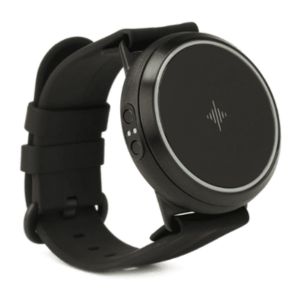
Soundbrenner Core Steel Musician's Smartwatch
Features: 20-400BPM Tap Metronome, dB Meter, Magnetic Contact Tuner
Benefits: Massive range of features, Easy to feel vibration, Great for recording
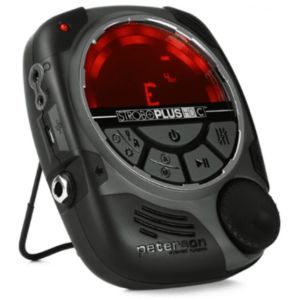
Peterson StroboPlus HDC
Features: Custom temp maps, 10-280BPM, 90 Accent patterns
Benefits: Dual tuner/metronome functionality, Highly customizable, Extremely accurate performance
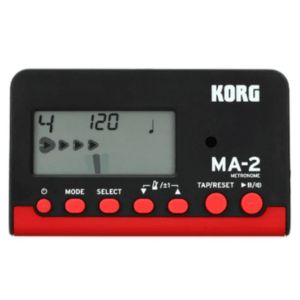
Korg MA-2 Metronome
Features: 30-252BPM, Tap tempo, Reference pitches C4-B4
Benefits: Pocket sized, Rhythms for a variety of styles, Excellent battery life
Contents
Our Top 3
The Peterson StroboPlus HDC is our Top Pick for this list. This handheld metronome comes with a vast array of beat subdivisions, accent patterns, polyrhythms, and more to truly help you develop a great sense of time.
Korg MA-2 is our Best Budget choice. It comes in a proven Korg design that’s been popular for decades thanks to its fantastic convenience, ease of use, and portability.
Finally, the Soundbrenner Core Steel Musician’s Smartwatch is our Editor’s Choice. It comes in a novel design that redefines the paradigm of what a metronome can be, and attaches to your body to let you feel each pulse. This metronome is for the discerning musician willing to try something different.
Individual Reviews
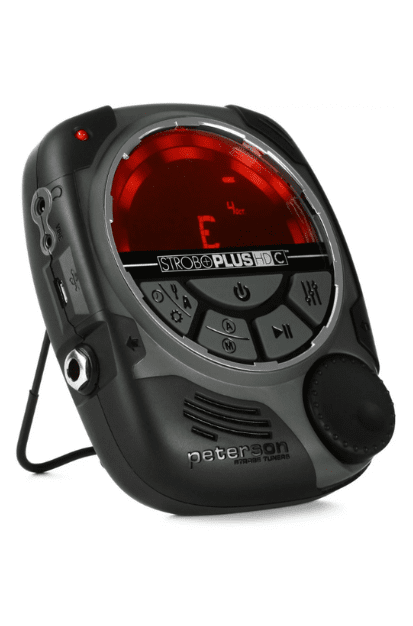
Peterson StroboPlus HDC
A versatile metronome that doubles as a tuner.
This is a metronome for musicians that are willing to take their concept of time to the next level. With several subdivisions and ways to use its click, this metronome can help you develop a much stronger sense of time. It also doubles as an accurate tuner with renowned Peterson technology.
The Peterson StroboPlus HDC is a handheld metronome and tuner packed with fantastic features. It offers hundreds of possible beat subdivision combinations, different accent patterns, and plenty of polyrhythms.
This metronome also allows you to load your own custom tempo maps, so you can take your practice sessions to the next level. To give you even further options, you can use this metronome with the free Peterson Connect app.
On this app, we were able to create sweeteners and arrange sweetener presets in order to have easy access for use during live shows. Additionally, we liked how easy it was to upload tempo maps in order to use in very specific practice sessions and for use in concerts.
The Peterson Connect app allows for easy firmware updates. Thanks to its many options, you can go beyond using the metronome as a click-on-one to developing an advanced concept of time.
In addition to being a very versatile metronome for dedicated musicians, the Peterson StroboPlus HDC is a fantastic tuner that delivers accurate tuning within ±0.1 cent, with a built-in microphone, and a 1/4-inch input jack for acoustic and electric instruments.
And for those who like to practice in dim light conditions, this metronome comes with a high-definition LCD screen. This screen features a variable-color LED backlight for great contrast. You can even use it under direct sunlight or very bright stage lighting.
Verdict: The Peterson StroboPlus HDC is a versatile handheld metronome that also features a highly accurate tuner. You get a vast array of beat subdivision combinations, several accent patterns, and plenty of polyrhythms as well. With fantastic build quality, this metronome offers you plenty of options with Peterson quality.
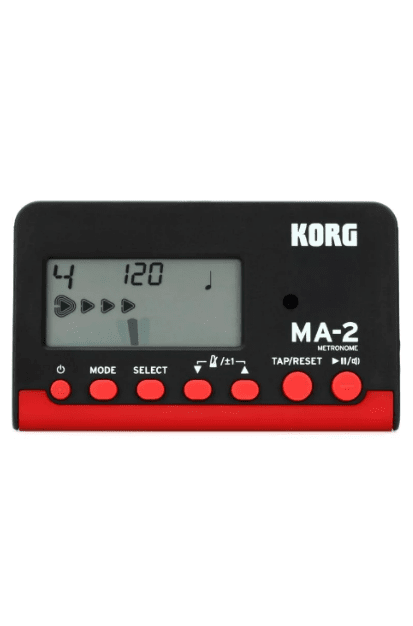
Korg MA-2
A simple and effective metronome with proven Korg quality.
This metronome comes in the beloved traditional Korg form factor for metronomes and tuners. It offers you plenty of options to place the beat wherever you want in order to help you develop a stronger sense of time.
The Korg MA-2 metronome features an improved display that makes it easier to interact with the different options. These options include an assortment of rhythms to choose from, tap tempo, etc.
Additionally, you can choose to accent up to nine different beat positions. This fact alone gives the user incredible versatility to practice using the metronome in creative ways.
For instance, in our tests, we set up a 4/4 time signature but accented beat four instead of one. This is a great way to practice time and makes working on your instrument a whole lot more fun.
Next up, we did a 6/4 time and put the beat on five. In all honesty, this was a bit challenging for us, and also a great idea for future practice sessions. This metronome allows you to spice up your practice routines quite a bit.
We tried everything from scales and patterns to even playing entire songs while placing the metronome in uncommon beat choices. It’s hard to overstate how effective this is to improve time. The Korg MA-2 had us on our toes and all of this in a very affordable metronome.
In true Korg fashion, this metronome comes in the popular form factor the company is known for. Plenty of guitarists everywhere know and love the very convenient and light rectangular shape that Korg metronomes and tuners have employed for decades.
You can either use it flat against a surface or angle its back support in case you wish to have a better visual reference. You can also figure out what tempo a given song is in via the Tap Tempo function on the MA-2.
This metronome has a range that goes from 30 to 252 bpm, works on 2 AAA batteries, and weighs only 2.4 oz. In short, a fantastic tool to enhance your practice sessions and at a great price.
Verdict: The Korg MA-2 is an affordable metronome that features an improved display as well as an assortment of rhythms and features. It’s a great choice for any musician looking for functionality at a low price.

Soundbrenner Core Steel Musician's Smartwatch
A unique metronome for the discerning musician.
This is an outside-the-box take on timekeeping that can work wonders for practice and live band sessions. Besides being a precise and unique metronome that lets your body know where the beat is, it also has a tuner and dB meter.
The Soundbrenner Core Steel Musician’s Smartwatch is a metronome, a contact tuner for your headstock, and a dB meter with an alarm. Although the tuner and dB meter are certainly helpful, it’s the metronome that makes this “watch” so desirable.
This is a pulse-driven metronome that was designed as a tactile alternative to the traditional click metronomes we all know. The idea behind it is that the player stays on time by feeling the pulse of the metronome on their bodies.
In order to play with a band, the Core Steel Musician’s Smartwatch can sync up to five devices via Bluetooth. Although this metronome is designed to be worn mostly on your wrist, the package includes two bands so you have the option to wear it around your ankle, chest, and bicep as well.
We put this metronome to the test by wearing it on our wrist and setting the tempo at 80 bpm. We got a strong pulsation for every beat and were able to stay in time with this novel device.
Starting and stopping the metronome required only a quick double tap. When we wanted to try the tap tempo function, we simply triple-tapped it to activate it.
This metronome is driven by a large 7 G ERM motor and modern haptic driver so it can produce a pulse that is 7 times stronger than your average smartwatch or smartphone. This metronome works in tandem with Soundbrenner’s Metronome app, where you get a vast variety of presets and much more.
Besides the fact that the vibration is strong and unmistakable, this metronome also protects your hearing, as you are able to forgo the sometimes deafening click that often comes through in-ear monitors.
In short, a fantastic solution for practice and the stage, with a novel design and concept.
Verdict: The Soundbrenner Core Steel Musician’s Smartwatch is a truly unique metronome that works by pulsating on your body. This modern design also preserves your ears by avoiding the click that’s often too loud on in-ear mixes.
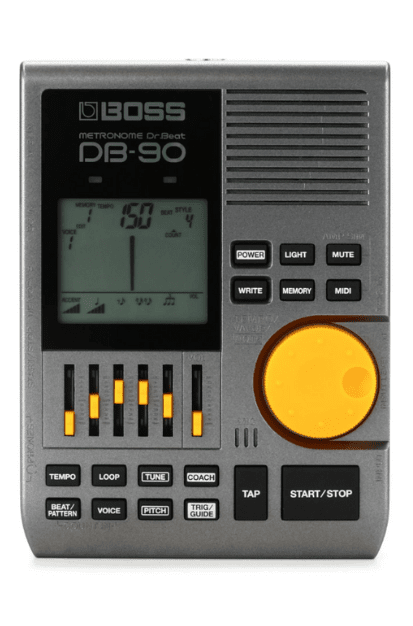
Boss DB-90 Dr. Beat
One of the most traditional and beloved metronomes ever.
This metronome has been around for years and is still quite popular among dedicated musicians. It comes loaded with features and a simple design that is intuitive and easy to operate.
The BOSS DB-90 Metronome has been one of the most popular metronomes for professionals for decades. It features four click sounds as well as several drum patterns to accompany you while you play.
One of the greatest assets of the DB-90 is its Note Mixing. This function allows you to create a variety of beats on the spot by adjusting the levels of five different note values. For instance, in our tests, we set it in 4/4 and accented the end of beats three and four, for a unique and very effective way to train our sense of time.
This metronome is also very intuitive to use. It features front-panel sliders to pick which notes and how much to accent them, and a large rotary dial for immediate access to edit parameters.
We also loved to try the different PCM drum patterns to practice with. These patterns are a great tool for developing accuracy and alternate with the use of the regular metronome.
Another great feature on the DB-90 is Rhythm Coach. It comes with four training modes that allow you to work on accuracy, speed, and endurance. Additionally, you can use the onboard microphone to use the Rhythm Coach functions in a variety of settings and contexts.
For instance, we were able to use the direct guitar input onboard the DB-90 to practice without the need for any other gear. We monitored our practice session via headphones for ultimate convenience.
Other great features include MIDI-in for syncing to tempos provided by an external sequencer, human-voice count, and tap tempo. In short, this is a fantastic and very complete metronome for professionals. If you’re a beginner or prefer a simpler metronome, you may want to look elsewhere.
Verdict: The BOSS DB-90 is one of the most enduring metronomes and comes loaded with features that can take your understanding of time to a new level. It’s built with the quality and functionality that Boss is known for and is one of the best choices for professionals.
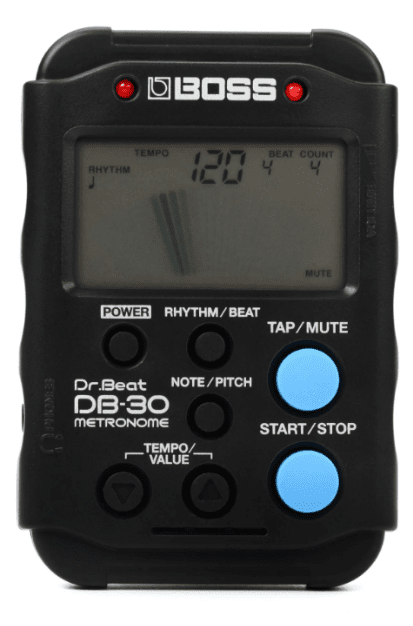
Boss DB-30 Dr. Beat
A compact and affordable metronome for beginners.
This metronome is a good option for beginners looking to work on their sense of time. It offers time signatures up to 17 beats per measure and comes in a compact and sturdy form factor.
The Boss DB-30 Dr. Beat metronome easily fits on most pockets and features a great variety of rhythm patterns and time feels. This clip-on metronome also features a tuner and is well-built with proven Boss quality.
We loved how compact and intuitive the DB-30 is to use. In our tests, we went through the nine rhythm types and 24-beat variations that this versatile metronome offers. We particularly liked some of the odd time and clave patterns, letting us work on our Latin repertoire and techniques.
We practiced some montunos and played through a few boleros, before moving on to accenting different parts of the beat. The LCD needle on the DB-30 was also of great help as a visual tempo reference, as well as the two bright LED lights indicating where the beat was.
Like many metronomes, the DB-30 comes with a Tap Tempo feature you can rely on whenever you need to find the pulse. For optimizing battery life, this metronome also comes with an auto power-off function.
Additional features include a headphone jack with volume control and a mute function. Overall, this is a good, convenient, and affordable metronome for beginners. Professionals may want to invest in a more sophisticated model.
Verdict: The Boss DB-30 Dr. Beat is a good choice for beginners who want to go beyond a single-click metronome. With a variety of rhythm patterns and time feels, this clip-on metronome is small and well-built, so you can take your practice anywhere you need to go.
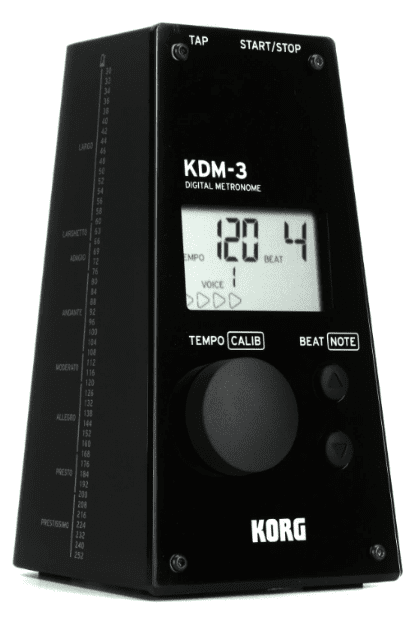
Korg KDM-3
A classic metronome design gets a digital update.
The Korg KDM-3 brings that traditional metronome design but puts a spin on it by making it digital. It's got that classic and stylish look but with the functionality of a modern metronome and all the quality we've come to expect from Korg.
The Korg KDM-3 builds on the popular Korg KDM-2 metronome, but adds the classical design that metronomes were known for decades ago, as well as enhanced features. These include a louder onboard speaker and a tempo range that goes from 30 to 252 bpm.
You also get 19 beat patterns to practice with and eight different metronome sounds.
Other noteworthy features include Tap tempo, an 1/8″ output to plug your headphones, and BPM markings that provide tempo ranges for largo, presto, adagio, allegro, and more.
In our tests, we set up the KDM-3 in a variety of beats per measure. We started at three beats per measure and chose to accent triplets while omitting the middle note. This was a fantastic challenge for us, as we played through some jazz standards in this unusual but very effective metronome setting.
For another unique but more manageable setting, we set it up at 8 measures accenting quadruplets while we ran through some scales and arpeggios. The volume can go up quite a bit, but we found it best when it was at a midpoint, as we were in a relatively quiet environment.
Our favorite click sound to use was that of a mechanical metronome, but the other voices also worked just fine. It will be a matter of taste as to which one of the eighth you decide to use.
Another fantastic feature on this Korg metronome was Timer mode. Here we were able to have the metronome on for a specified amount of time and then have it automatically stop. This is a great tool for serious practice, as it lets you know exactly how much time you’ve put in.
In short, this is a great metronome with a classic feel and a modern build. However, it may be a bit too bulky for folks who value convenience.
Verdict: The Korg KDM-3 looks like a mechanical metronome, but is digital and comes with plenty of features. It includes a timer that stops once you’ve reached the time you set, which is great for keeping precise track of your practice sessions.

Korg TM-60
A timeless Korg design for ultimate convenience.
An easy-to-use metronome that has everything you need to work on your time, and that also includes a tuner. You can take this undersized device anywhere, as it is very compact and lightweight and will fit in any small space on your guitar case or gig bag.
The Korg TM-60 is a reliable metronome that also doubles as a tuner. It comes with a backlit display that lets you monitor its operation and 130 hours of battery life.
This metronome also features a C1 to C8 detection range as well as an auto power-off function. As is common with this beloved decades-old Korg design, it features a built-in stand so you can angle it on any surface.
With a range from 30 to 252 bpm, the TM-60 can comfortably handle all your tempo needs, from excruciatingly slow to blistering fast. On top of that, you get 15 onboard rhythm variations to help keep your practice sessions fun and challenging.
The TM-60 also includes a memory backup that saves the metronome’s time signature, as well as the tuner’s calibration. In order to save battery, the TM-60 comes with an auto power-off function that turns off the metronome following 20 minutes of inactivity.
Overall, a great metronome for beginners who need to practice everywhere they go. It is well-built, effective, and simple to use. Folks looking to get more advanced features may want to consider another model.
Verdict: The Korg TM-60 employs the ever-popular and classic form factor of simple Korg metronomes and tuners. It’s reliable, small, well-built, and extremely convenient, making it a great choice for students and beginners.
How to Choose The Right Metronome For You
Simply stated, a metronome is used to help you play at the right tempo. It typically achieves this by producing a clicking sound at every beat, which can be combined with a bell-like sound at the beginning of each new bar.
A metronome is used by beginners and professionals alike, as the musician works through different problems while staying on time.
What Metronome to Get
If you’re a beginner or just need a simple metronome, start by looking at affordable digital metronomes that offer basic functions. These typically include a beeping sound you can place at different points of different beats, as well as a tempo range that lets you go very slow or very fast.
More expensive models come with a series of features that more advanced players usually need. Enhanced metronomes often come with drum patterns, tap tempo, several beat subdivision options, odd time signatures, and more.
These more advanced models also tend to offer a guitar/bass tuner and are built for professionals who want to further develop their sense of time.
The third kind of option is the mechanical metronome. These metronomes operate employing a clockwork mechanism driven by a weighted pendulum. The tempo is set by modifying the counterweight, usually a block that you can slide up and down the length of the pendulum.
Some Classical music teachers swear by mechanical metronomes, which are simple, effective, and avoid all distractions. The pendulum on a mechanical metronome offers a precise and clear visual cue, which is often imitated by digital metronomes on a screen.
Using a Metronome
The first step is to set the tempo you’ll be working with. If working on a classical piece, the tempo is usually found on the top part of the beginning of said piece.
If you’re just working on essentials like scales, arpeggios, patterns, etc, simply set the metronome at a starting pace that’s comfortable for you. Make sure you have the fingering down before you start working with a metronome. In other words, be able to play the scale or passage clearly before you attempt to integrate the metronome.
At first, use a metronome at the beginning of each beat and at simple time signatures. For instance, have it beep at each downbeat of a 4/4 time signature. Then, you can set it to beep at beats 1 and 3, and then beats 2 and 4.
Then, try placing it in just one beat, for instance, beat 3. Once you have that down, move on to making it beep at the upbeats. Then repeat the process.
The above is just scratching the surface of how to use a metronome. A good teacher can help you use it in creative ways and specifically target your weak areas so you can get better at the instrument.
Final Thoughts
A metronome is an essential tool for any musician wanting to improve. Playing with a good sense of time is paramount to making the music groove and communicate. Its importance cannot be overstated.
The metronome is arguably the best tool to develop a good time, and you can use it in a variety of ways. Some go as far as saying every single practice session should include at least a bit of metronome work.
To recap our favorites, the Peterson StroboPlus HDC is our Top Pick. This is a very complete, versatile, and convenient metronome that has everything a musician needs to practice time in a variety of ways.
The Korg MA-2 is our Best Budget choice and comes in a beloved Korg design that has been widely used in many of this company’s metronomes and tuners, offering convenience and portability.
Finally, the Soundbrenner Core Steel Musician’s Smartwatch is our Editor’s Choice. This is a truly unique tool that attaches to your body or wrist to let you feel each pulse. This metronome is for the discerning musician willing to pay for the best.

